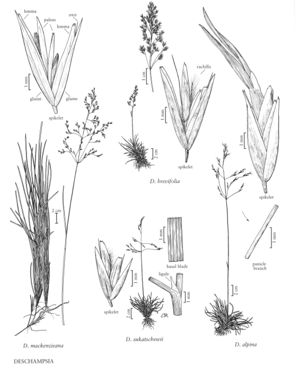Deschampsia mackenzieana
Plants loosely cespitose. Culms 30-80 cm, smooth, glabrous, sometimes decumbent at the base and rooting at the lower nodes. Basal leaves not forming a tuft; sheaths smooth; ligules 4-7.5 mm, acute; blades 1-3 mm wide, convolute to involute, abaxial surfaces smooth, adaxial surfaces scabrous. Panicles 10-20 cm long, 8-14 cm wide; branches ascending to laxly diverging or reflexed, somewhat scabrous, longest branches at the lower nodes usually undivided for 1/3-1/2 their length. Spikelets 6-7.5 mm, bisexual. Glumes acuminate, equaling or slightly longer than the distal floret; callus hairs 1.5-2 mm; lemmas 4.5-5.5 mm, awns attached on the lower 1/4 - 2/3, inconspicuous, weakly geniculate, from shorter than to exceeding the lemma by approximately 2 mm; anthers 1.5-2.7 mm. 2n = 52.
Discussion
Deschampsia mackenzieana grows on the sandy shores and dunes around Great Slave Lake, Northwest Territories, and Lake Athabasca, Saskatchewan. The decumbent culms of some plants may be a response to shifting substrate.
Selected References
None.
